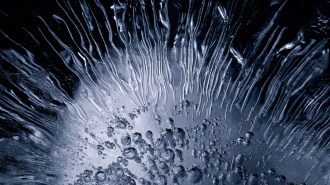Between the Sheets: In reactors and nanotubes, errant atoms get a grip
Reach out and touch each other. That’s something that carbon atoms in adjoining layers within graphite aren’t supposed to do–even in the cores of nuclear reactors where graphite blocks take a beating from neutron radiation.
New atomic-level simulations in England challenge that expectation. The findings, if confirmed, may revise not only the way that specialists handle spent nuclear-reactor cores but also how technologists build novel, nanometer-scale carbon structures.
Graphite has a crystal structure consisting of many one-atom-thick carbon sheets known as graphene. The spacing between sheets is more than twice that between atoms within the sheets, so the forces between sheets are extremely weak.
Now, Rob H. Telling of the University of Sussex in Brighton and his colleagues find that carbon atoms near neutron-punched holes in graphene make surprising, transient movements into the zone between layers. As they briefly dangle there, many atoms from adjacent sheets meet and form strong bonds, the researchers suggest.
These and other unexpected bonds that the simulation predicts modify properties ranging from a graphite crystal’s size to its electric and thermal conductivities, Telling says.
In the May Nature Materials, he and his colleagues describe a surprising set of irregularities that showed up in computer simulations of a 64-atom, two-sheet portion of a graphite crystal.
Their report “sheds significant new light on an issue which has been studied for some 50 years but still remains poorly understood,” comments Kai Norlund of the University of Helsinki. “If the results are eventually verified, this work should become a seminal paper in the field.”
Scientists have long known that the graphite used to slow down neutrons shooting from the fuel in old-style nuclear reactors accumulates crystal defects that store energy. The potential danger of that energy was demonstrated in 1957 by the world’s third-worst nuclear accident, the Windscale fire in Sellafield, England.
Too-sudden release of energy stored in graphite defects made the Windscale reactor core catch fire and unleash significant radioactivity into the air.
While the nuclear-power industry has changed the type of reactors in use, it still must dispose of some 150,000 tons of irradiated graphite as defunct reactors are dismantled. The nuclear-power company British Nuclear Fuels partly funded the Sussex study in a quest for deeper understanding of radiation-induced defects in graphite. That information could improve disposal methods to avoid a sudden release of energy.
The new work has also struck a chord in an up-and-coming industrial sector–the Lilliputian world of carbon nanostructures. By revealing new atomic arrangements caused by irradiation in graphite, the simulations may aid scientists using radiation, specifically electron beams, to engineer graphitelike nanostructures such as carbon nanotubes (SN: 2/15/03, p. 110: Available to subscribers at Streams plus nanostrands equals electricity).
“I am very excited about this,” comments David Tomanek of Michigan State University in East Lansing. Experimenting with such radiation-induced defects will have an important effect on nanotechnology, he predicts.
****************
If you have a comment on this article that you would like considered for publication in Science News, send it to editors@sciencenews.org. Please include your name and location.







